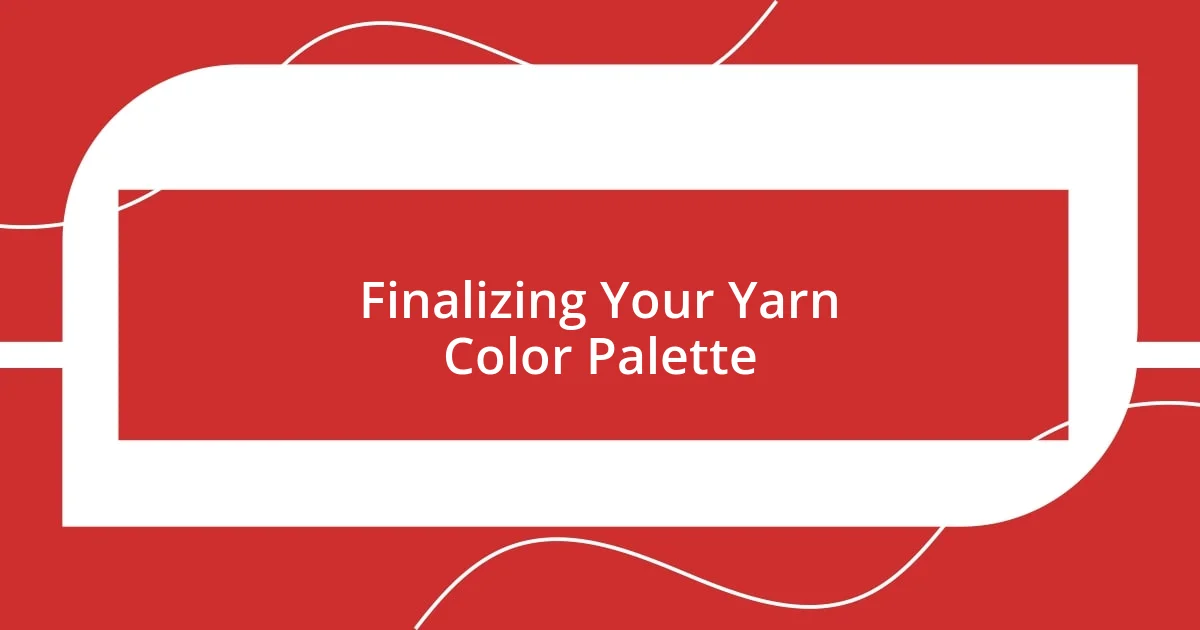Key takeaways:
- Understanding color theory is essential for effective color selection, involving primary, secondary, and tertiary colors, as well as emotional impacts and harmony or contrast in designs.
- Choosing colors should reflect personal connection, project purpose, seasonality, contrast, and texture to convey desired moods and enhance creativity.
- Adjusting for lighting conditions and being open to spontaneous color choices can significantly influence the final outcome and emotional resonance of a project.

Understanding Color Theory Basics
Color theory can seem a bit intimidating at first, but I’ve found that breaking it down into its core components makes it much easier to grasp. At its heart, it revolves around the color wheel, which organizes colors into primary (red, blue, yellow), secondary (green, orange, purple), and tertiary hues. I often refer to the color wheel when I’m unsure — it’s like having a reliable friend for color choices.
As I experiment with colors, I’ve discovered the emotional impact they can carry. For instance, warm colors like reds and oranges evoke energy and passion, while cool colors such as blues and greens create feelings of calm and tranquility. When I chose a vibrant red yarn for a scarf, I felt a surge of warmth and excitement, as if I were wrapping myself in joy.
Contrast and harmony are also key concepts in color theory. High contrast can make a design pop, while harmonious colors can create a soothing effect. I remember knitting a blanket in complementary colors, and the result was stunning yet balanced. It made me wonder—how does each choice we make in our projects shape not just the physical piece but our emotions tied to it?

Choosing Colors for Your Project
Choosing colors for your project can really make or break your creation. I always consider the theme or mood I want to convey; it’s similar to choosing an outfit for a special occasion. For example, when I crafted a baby blanket, I opted for soft pastels that radiated warmth and tenderness, perfect for a little one. It’s fascinating how certain colors can evoke specific feelings, steering the project’s overall vibe.
Here’s a quick list of factors to consider when picking your colors:
- Personal Connection: Think about colors that resonate with you or hold personal significance.
- Project Purpose: Reflect on where or how the finished piece will be used.
- Seasonality: Different colors suit different seasons—think bright yellows and greens for spring.
- Color Contrast: Consider how colors interact; high contrast can add excitement, while complementary shades offer balance.
- Yarn Texture: Sometimes the texture of the yarn influences how colors appear; a fluffy yarn may soften the hues.
I have learned that letting my feelings guide my selection often leads to the most joyful projects! Each time I pick my yarn, I feel a mix of anticipation and creativity bubbling up.

Evaluating Your Personal Style
Evaluating your personal style can be an enlightening journey. I’ve found that it’s vital to take stock of what colors truly resonate with you. For instance, I used to shy away from bold, bright hues—thinking they were too loud. But after trying out a vibrant teal for a shawl, I discovered that those colors not only matched my personality but also lifted my spirits every time I wore that piece.
I also believe that examining your wardrobe can provide clues about your color preferences. Are there shades you gravitate towards often? I once noticed that I frequently picked shades of green and blue, which eventually led me to select yarn in those same tones for a tunic. It felt like I was knitting a piece of my identity, bringing a tangible aspect of my style into my crafting.
It’s important to remember that evaluating your personal style isn’t a rigid process; it’s quite fluid. I often experiment with colors I might not normally choose, which can lead to delightful surprises! Recently, I took a chance on a mustard yellow yarn for a beanie. To my joy, it became a statement piece that not only brightened up my outfits but also drew compliments. Each color choice tells a story, and the right ones can transform our creations into something uniquely reflective of who we are.
| Factors to Consider | My Experience |
|---|---|
| Emotional Resonance | I often select colors that evoke a sense of joy or tranquility. Vibrant colors lift my mood, while softer shades bring about calmness. |
| Wardrobe Reflection | My closet nudged me towards greens and blues, leading me to recreate those tones in my knitting projects. |
| Adventurous Choices | Taking risks with colors, like mustard yellow, has led to unexpected favorites that enhance my personal style. |

Testing Yarn Colors Together
When testing yarn colors together, I often set up a mini workspace where I can see different combinations side by side. Just last week, I laid out a selection of earthy browns and vibrant oranges for a fall-inspired throw. Seeing them in natural light, I could instantly tell that the warm tones complemented each other beautifully, sparking an exciting creative urge within me.
I’ve also found that knitting small swatches can be incredibly illuminating. A few months ago, I knitted a simple square using a color palette of muted blues and greens. The moment I saw the interplay of the colors, I understood how much depth they added to my project. The subtle shifts in tone gave the overall piece a calming effect, which was exactly what I wanted to convey. Have you ever felt a color combination just click? It’s a thrilling moment when everything comes together.
Finally, I recommend taking photos of your color choices as you test them. This trick has served me well, especially when I’m indecisive. I remember struggling to pick shades for a scarf last winter and snapped a quick shot of my options against a cozy backdrop. Later, reviewing those images, the colors that resonated most popped out at me, making the decision process feel easier and even more exciting!

Considering Color Psychology Effects
Color psychology has always fascinated me, especially how different hues can influence our feelings and decisions. For instance, the other day, I picked a deep blue yarn for a project, hoping to capture a sense of calm. As I worked, I noticed my anxiety from the day melting away with each stitch. Isn’t it amazing how something as simple as color can affect our mood with such immediacy?
I often reflect on my experiences with warmer colors, too. Last summer, I experimented with a rich, sunny yellow for a summer top. Initially, I hesitated, worrying it might feel too bright. But once I completed the piece, I realized it radiated pure joy. Every time I wore that top, it became a beacon of positivity, attracting smiles and compliments. It made me wonder, how often do we shy away from colors that could enhance our emotional state?
Considering color psychology not only shapes the way I create but also the way I interact with others. I recall knitting a playful pink scarf that instantly drew attention. It sparked conversations with strangers and even old friends. It’s fascinating to think about how colors can act as a social catalyst, don’t you think? It really drives home the point that the colors we choose are not just about personal preference; they resonate and connect us to our environment and the people within it.

Adjusting for Lighting Conditions
When selecting yarn colors, it’s essential to consider how lighting can dramatically change the perception of those hues. I vividly recall a time when I chose a deep burgundy yarn in my brightly lit craft room. However, once I took it outside during golden hour, it appeared more vibrant than I had anticipated, almost leaning toward a red. I learned right then that the surrounding light completely transforms color interpretation.
I also experiment with yarn shades under various light sources, especially when daylight fades and lamps light up the space. A few weeks ago, I worked on a project during the evening with warm, ambient lighting. To my surprise, colors that seemed muted in daylight sprang to life in the soft glow, enhancing the mood of my knitting. Have you ever noticed how certain colors can evoke a warmer, cozier feeling once the sun goes down?
This careful attention to lighting has reshaped how I approach my projects. I now regularly sample my yarns at different times of the day and in various environments, consciously observing their shifts. Just last month, I was caught off guard while working on a pastel baby blanket. By morning, those soft pinks and blues had a lovely clarity, but by dusk, they morphed into a dreamier palette that felt almost nostalgic. Isn’t it remarkable how simply adjusting your surroundings can make such a profound difference in creative expression?

Finalizing Your Yarn Color Palette
Finalizing your yarn color palette can be both exhilarating and daunting. One time, I was pinning down colors for a cozy blanket and felt stuck. I laid out a few shades on my kitchen table, and as I arranged them, I realized how essential it is to see them together. It’s like watching a movie unfold—colors interact and tell their own story.
I often find myself playing with complementary and contrasting colors. Recently, I decided to combine a deep teal with a bright coral for a small bag. At first, I was unsure about the clash of tones, but together, they created a vibrant energy that I couldn’t resist. Isn’t it interesting how the juxtaposition of two seemingly opposing colors can spark excitement in a project?
I’ve learned that it’s crucial to trust my instincts while finalizing my palette. One evening, I was convinced that a muted gray would ground my project beautifully. But after some reflection, I swapped it out for a cheerful mint green that lifted the entire vibe. Do you think it’s essential to stay true to your original vision, or should we remain open to unexpected changes? For me, allowing room for spontaneity in my color choices often leads to delightful surprises.












